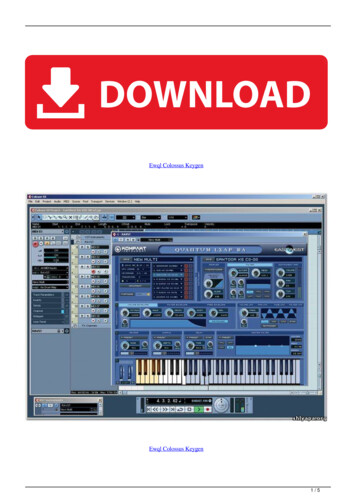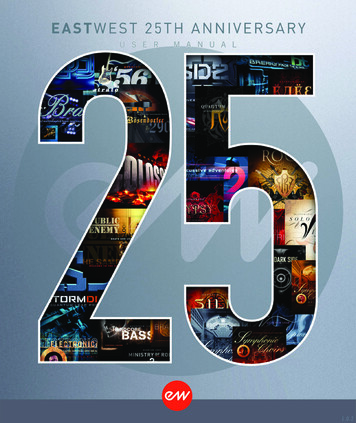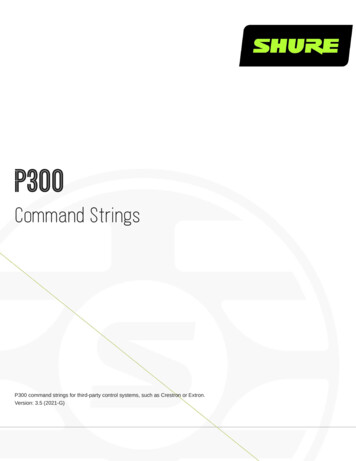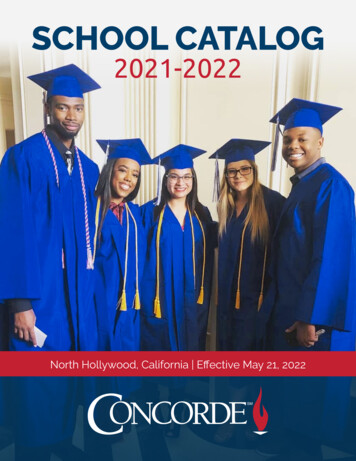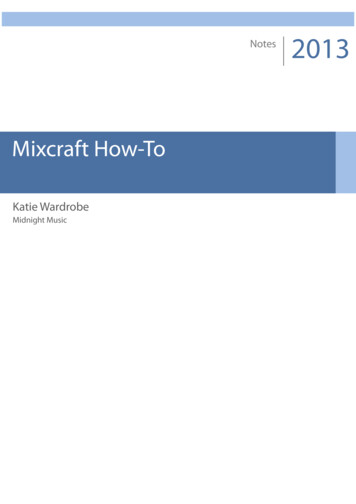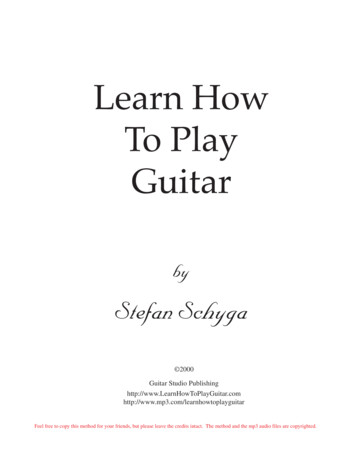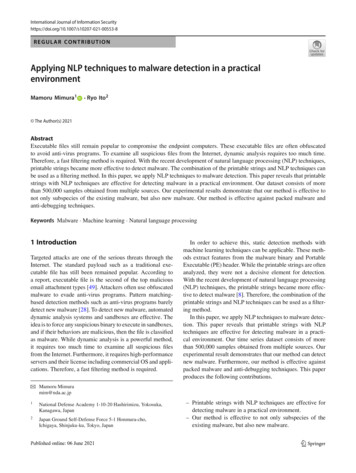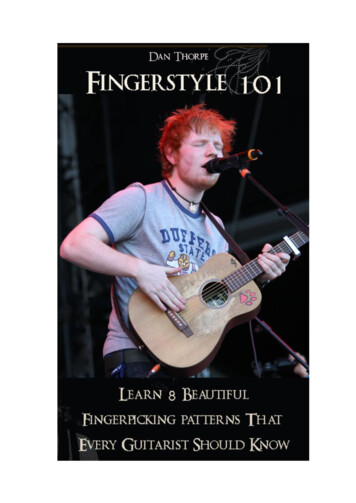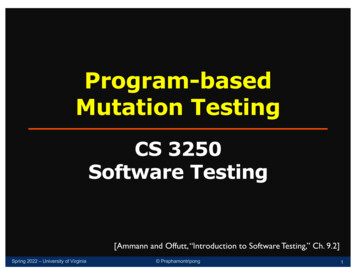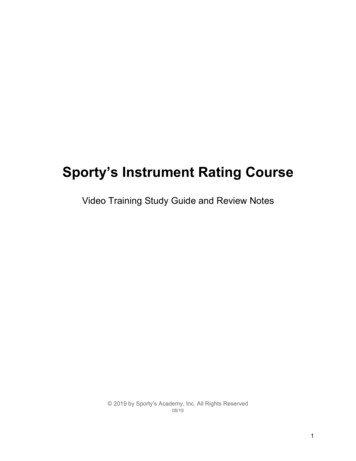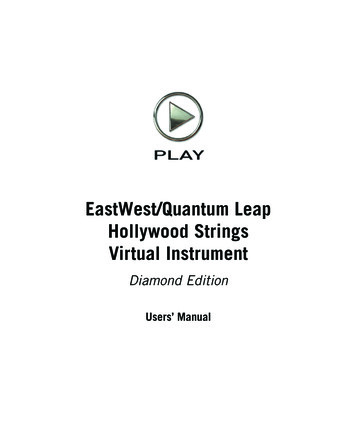
Transcription
EastWest/Quantum LeapHollywood StringsVirtual InstrumentDiamond EditionUsers’ Manual
EASTWEST/QUANTUM LEAP HOLLYWOOD STRINGSThe information in this document is subject to change without notice and does not represent a commitment on the part of East West Sounds, Inc. The software and soundsdescribed in this document are subject to License Agreements and may not be copied toother media , except for the purpose of copying the data to the personal computer systemhard drive of the licensed user. No part of this publication may be copied, reproduced orotherwise transmitted or recorded, for any purpose, without prior written permission byEast West Sounds, Inc. All product and company names are or trademarks of theirrespective owners.PLAY is a trademark of East West Sounds, Inc. East West Sounds, Inc., 2010. All rights reserved.East West Sounds, Inc.6000 Sunset Blvd.Hollywood, CA 90028USA1-323-957-6969 voice1-323-957-6966 faxFor questions about licensing of products: licensing@eastwestsounds.comFor more general information about products: .comVersion of June 2011ii
EASTWEST/QUANTUM LEAP HOLLYWOOD STRINGS1. Welcome2345678889About EastWestProducer: Doug RogersProducer: Nick PhoenixProducer: Thomas BergersenSound Engineer: Shawn MurphyCreditsHow to Use This and the Other ManualsUsing the Adobe Acrobat FeaturesThe Master Navigation DocumentOnline Documentation and Other ResourcesClick on this text to open theMaster Navigation Document1
EASTWEST/QUANTUM LEAP HOLLYWOOD STRINGSWelcomeAbout EastWestEastWest (www.soundsonline.com) has been dedicated to perpetual innovation and uncompromising quality, setting the industry standard as the most critically acclaimedproducer of Sample CDs and Virtual (software) Instruments.Founder and producer Doug Rogers has over 30 years experience in the audio industryand is the recipient of over 60 industry awards, more than any other sound developer.His uncompromising approach to quality, and innovative ideas have enabled EastWest tolead the sound-ware business for more than 22 years.In 1997 Rogers partnered with producer/composer Nick Phoenix and set up QuantumLeap, a wholly owned division of EastWest, to produce high-quality, no-compromise sample libraries and virtual instruments. Quantum Leap virtual instruments are mostly produced by Nick Phoenix. Some of the larger productions, such as Symphonic Orchestra,Symphonic Choirs, Quantum Leap Pianos, and Hollywood Strings are co-produced byDoug Rogers and Nick Phoenix. As a composer, Phoenix began scoring film trailers andtelevision commercials in 1994. To date, he has either scored or licensed music for thead campaigns of over 1000 major motion pictures including Tomb Raider 2, Terminator3, Lord of the Rings Return of the King, Harry Potter 2, Star Wars Episode 2, Spiderman3, Pirates of the Caribbean 3, Blood Diamond, Night at the Museum, and The Da VinciCode. Quantum Leap has now firmly established itself as one of the world’s top producers of high-end sample libraries and virtual instruments.In 2006, EastWest purchased the legendary Cello Studios (formerly United Western Recorders) on Sunset Boulevard in Hollywood, re-naming it EastWest Studios. The 21,000sq. ft. facility, since remodelled by master designer Philippe Starck, houses five recording studios and is the world headquarters for EastWest.Chapter 1: Welcome2
EASTWEST/QUANTUM LEAP HOLLYWOOD STRINGSProducer: Doug RogersWith over 30 years experience in the audio industry, founder and producer Doug Rogersis the recipient of over 60 industry awards, more than any other sound developer. Hisuncompromising approach to quality, and innovative ideas have enabled EastWest tolead the sound-ware business for more than 22 years. “The Art of Digital Music” namedhim one of “56 Visionary Artists & Insiders” in the book of the same name.He released the very first commercial Drum Samples CD in 1988, and followed it withthe multiple award-winning “Bob Clearmountain Drums” sample collection which he coproduced. In the years that followed he practically reinvented the sound-ware industry.EastWest introduced loop sample libraries to the market in the early nineties, followedclosely by the first midi driven loops collection (Dance/Industrial). He released the firstlibrary to include multiple dynamics, followed by the first sample library to stream fromhard disk, an innovation that led to the detailed collections users expect today.His recent productions are Symphonic Orchestra (awarded a Keyboard Magazine “Key BuyAward,” EQ Magazine “Exceptional Quality Award,” Computer Music Magazine “Performance Award,” and G.A.N.G. [Game Audio Network Guild] “Best Sound Library Award”);and Symphonic Choirs (awarded Electronic Musician “2006 Editor’s Choice Award,”G.A.N.G. “Best Sound Library Award,” and Keyboard Magazine “Key Buy Award”). Mostrecently, his productions include Quantum Leap Pianos, the most detailed virtual pianocollection ever produced; and Fab Four, inspired by the sounds of the Beatles, a M.I.P.AWinner and judged the most innovative instrument by 100 music magazines.Over the last decade he has partnered with producer/composer Nick Phoenix and set upthe Quantum Leap imprint, a subsidiary of EastWest, to produce high-quality, no-compromise virtual instruments. EastWest/Quantum Leap virtual instruments are consideredthe best available and are in daily use by the who’s who of the industry.Chapter 1: Welcome3
EASTWEST/QUANTUM LEAP HOLLYWOOD STRINGSProducer: Nick PhoenixNick began scoring film trailers in 1994. To date, he has scored or licensed music forthe ad campaigns of over 1000 major motion pictures. “Star Trek,” “Tron,” “Percy Jackson,” “Twilight,” “2012,” “WALL-E,” “Indiana Jones 4,” “Harry Potter 6,” “Inkheart,”“Tales Of Despereaux,” “300,” “A Christmas Carol,” “Watchmen,” “Angels and Demons,”“Night at the Museum,” and “Young Victoria” are a few recent examples. Nick founded“Two Steps From Hell” with Thomas Bergersen in 2006. www.twostepsfromhell.comThe journey as a composer has inspired Nick to record and program his own soundsand samples. Nick founded Quantum Leap Productions in 1997 and Quantum leap hassince grown to be the world’s top producer of high-end virtual instruments. A 13-yearpartnership with Doug Rogers and EastWest has yielded award winning software titlessuch as Stormdrum 1 and 2, Symphonic Orchestra, Symphonic Choirs, Silk, RA, VoicesOf Passion, Ministry Of Rock, Gypsy, Quantum Leap Pianos, Goliath, Hollywood Strings,and many others.“Hollywood Strings is the culmination of years of experience and the input of a reallystrong and diverse team. It is, by far, the best virtual instrument I have been involvedwith.”Chapter 1: Welcome4
EASTWEST/QUANTUM LEAP HOLLYWOOD STRINGSProducer: Thomas BergersenThomas Bergersen holds a composition and orchestration Master’s degree, and hasworked in the capacity of composer, orchestrator, or music arranger on many Hollywoodproductions.He founded Two Steps From Hell (www.twostepsfromhell.com) with Nick Phoenix in 2006and has since written music for countless movie trailers. “Star Trek,” “Harry Potter 6,”“Tales of Despereaux,” “The Dark Knight,” “Valkyrie,” “The Hulk,” “Rendition,” “SpiderMan 3,” “Golden Compass.” “The Assassination of Jesse James,” “Pirates of the Caribbean 3,” “Babel,” “Hitman,” “I Am Legend,” “300,” “No Country For Old Men,” “HarryPotter 5,” “The Brave One,” “Wall-E,” “Blood Diamond,” “Speed Racer,” and “Night atthe Museum” are a few recent examples.Thomas is also a trumpetist and has performed on major TV productions including NBCNews. In his pursuit of the ultimate realism in samples, he has produced a great numberof orchestral sample libraries for his own use. With Hollywood Strings, it was time to joinforces with veteran producers Doug Rogers and Nick Phoenix, and to share this knowledge with the rest of the world.Thomas’ studio is located in Santa Monica, California. www.thomasbergersen.comChapter 1: Welcome5
EASTWEST/QUANTUM LEAP HOLLYWOOD STRINGSSound Engineer: Shawn MurphyShawn Murphy is an Academy Award, C.A.S. (Cinema Audio Society), BAFTA, and Emmyaward-winning sound engineer who has recorded and mixed the scores for more than300 feature films including: “Indiana Jones and the Kingdom of the Crystal Skull,” “StarWars: The Phantom Menace,” “Star Wars: Episode II - Attack of the Clones,” “Star Wars:Episode III - Revenge of the Sith,” “Star Wars: A Musical Journey,” “Jurassic Park,”“Jurassic Park, The Lost World,” “Harry Potter and the Prisoner of Azkaban,” “Titanic,”“The Curious Case of Benjamin Button,” “The Bourne Ultimatum,” “Minority Report,”“Saving Private Ryan,” “Munich,” “The Passion of the Christ” (score mix), “X-Men: TheLast Stand,” “Memoirs of a Geisha,” “Ice Age 2,” and “Ice Age 3.”Hollywood Strings is the first virtual strings collection he has engineered.Chapter 1: Welcome6
EASTWEST/QUANTUM LEAP HOLLYWOOD STRINGSCreditsProducersDoug Rogers, Nick Phoenix, Thomas BergersenSound EngineerShawn MurphyProduction CoordinatorRhys MoodyProgrammingJustin Harris, Nick Phoenix, Thomas BergersenScriptingPatrick Stinson, Thomas Bergersen, Klaus VoltmerEditingArne Schulze, Pierre Martin, Justin Harris, Michael DiMattiaArt DirectionSteven Gilmore, Thomas Merkle, Doug Rogers, Nick Phoenix, Thomas BergersenSoftwareDoug Rogers, Nick Phoenix, Rhys Moody, Klaus Voltmer, Klaus Lebkucher,Julian Ringel, Patrick Stinson, Adam Higerd, Ezra Buchla,David Kendall, Nick Cardinal, Jonathan KranzManualJohn PhilpitChapter 1: Welcome7
EASTWEST/QUANTUM LEAP HOLLYWOOD STRINGSHow to Use This and the Other ManualsAll documentation for the EastWest PLAY Advanced Sample System and its libraries isprovided as a collection of Adobe Acrobat files, also called PDFs. They can be viewed onthe computer screen or printed to paper.Each time you install one of the PLAY System libraries, two manuals are copied to thefile system on your computer: The manual that describes the whole PLAY System. This, the largest of the manuals,addresses how to install and use all aspects of the software that are common to alllibraries. The library-specific manual, such as the one you are currently reading. This smallerdocument describes aspects that differ from one library to the next, such as the listof included instruments and articulations.Using the Adobe Acrobat FeaturesBy opening the Bookmarks pane along the left edge of the Adobe Acrobat Reader, theuser can jump directly to a topic from the section names. Note that some older versionsof Acrobat Reader might not support all these features. The latest Acrobat Reader canbe downloaded and installed at no cost from the Adobe web site. (As an example of ahyperlink, you can click on the last words of the previous sentence (“Adobe web site”)to be taken directly to the Adobe site.)When reading this and other manuals on the computer screen, you can zoom in to seemore detail in the images or zoom out to see more of the page at once. If an includedpicture of the user interface, or a diagram, seems fuzzy or illegible, then zoom in usingone of several means provided in the Acrobat Reader software. Note that images areclearest and screen shots most legible at 200% and next best at 100%.The Master Navigation DocumentBecause the EastWest PLAY System is a collection of components, each with its ownUser’s Manual, a Master Navigation Document (MND) is provided to allow users to jumpquickly between these PDFs when being read on the computer screen. This MND is aone-page file with hyperlinks to the PLAY System documentation and to all the librarymanuals. Hyperlinks to this Master Navigation Document are found on the title page ofeach chapter in each document. From there, you can open any other document in thecollection.For example, if you’re reading something in this documentation for the EastWest/Quantum Leap Hollywood Strings library, and need to open the manual for the PLAY Systemas well, go to any chapter title page and click on the link that says, “Click on this textto open the Master Navigation Document.” It will open in a new window on the screen.In that document, click on the icon for the PLAY System and its manual will open in thesame window, hiding the MND. You now have both the Hollywood Strings library manualand the PLAY System manual open in separate windows so you can refer to them both.Chapter 1: Welcome8
EASTWEST/QUANTUM LEAP HOLLYWOOD STRINGSSeparate Gold and Diamond ManualsThe EastWest/Quantum Leap Hollywood Strings virtual instrument is available in twoversions: Gold and Diamond. And each has a manual slightly different from the other,so it is important that you use the correct version of the manual. This is the manual forthe Diamond Edition. If you have the incorrect version of the manual, contact TechnicalSupport at EastWest.Online Documentation and Other ResourcesFor the most up to date information, visit the support pages at EastWest’s web site.There you can find: information made available after these manuals were written FAQ pages that may already list answers to questions you have suggestions from EastWest and other users of the EastWest PLAY System news about upcoming releasesThe address is:http://support.soundsonline.comYou can also visit the EastWest online forums. There you can read comments and questions from others who use EastWest products and post your own. The many forum participants are a good source of helpful information about both the technical and musicalaspects of this software.The address of the forums is:http://www.soundsonline-forums.comIf you visit the forums to receive support from EastWest (instead of going directly to thesupport site listed above), make sure you post your support request in the Support forumand not in the General Discussion forum.Chapter 1: Welcome9
EASTWEST/QUANTUM LEAP HOLLYWOOD STRINGS2. Hollywood Strings, An Overview111313The Design Point for the Hollywood Strings LibraryWhat’s IncludedHardware RequirementsClick on this text to open theMaster Navigation Document10
EASTWEST/QUANTUM LEAP HOLLYWOOD STRINGSHollywood Strings, An OverviewThe Design Point For the Hollywood Strings LibraryHollywood Strings was designed to be the most detailed collection of string orchestrainstruments ever assembled. And with their long history of creating virtual instruments,writing and scoring the music for hundreds of actual Hollywood trailers and films, coproducers Doug Rogers, Nick Phoenix and Thomas Bergersen already understood whatwas needed to create the authentic Hollywood sound.Another factor in defining the sound of this library is that it was recorded in EastWestStudio 1, formerly Western Recorders and then Cello Studios. The recordings created inthis building have, for decades, received more engineering awards than any other studio.Producers Doug Rogers, Nick Phoenix, and Thomas Bergensen,with (2nd from left) Sound Engineer Shawn MurphyThe combination of the right producers, an actual Hollywood recording studio, the bestmics and other recording hardware available, and string players familiar with the Hollywood sound all came together to capture the authentic sound you can hear in this virtualinstrument.When designing this library, the producers decided to take advantage of the recent advances in computer technology that make possible instruments of greater complexity toachieve more realistic results than libraries of even two years ago. For example, for overChapter 2: Quantum Leap Hollywood Strings, An Overview11
EASTWEST/QUANTUM LEAP HOLLYWOOD STRINGS20 years libraries have been recording multiple dynamics for each articulation and layering them to capture the different timbres heard at different dynamic levels. These libraries usually used the MIDI Velocity parameter to select which layer to play back. Whilethis approach achieved excellent results, it meant that typically 2 to 5 distinct layerswere available, and timbre could not change mid-note.Those libraries would use cross-fades for a small number of patches where mid-notechanges were beneficial. But they kept the number of those cross-fades small to preventtheir greater use of the computer’s memory from becoming overwhelming. In HollywoodStrings, the producers greatly expanded the use of cross-fades, both in their numbersand in how many concurrent voices participate in the cross-fades within a given patch.This approach results in instruments that capture the way string instruments can vary thesound during a crescendo or swell, or as the depth of vibrato changes, like a live musician playing an acoustic instrument.Studio 1 at EastWest Studios, during setup for the Hollywood Strings recording sessionsThe EastWest sample player software, known as PLAY, had to undergo a few improvements in version 2.0 to make these larger instruments possible, especially to improvethe efficiency of the software when loading and playing back large numbers of samplesin a single instrument.When all these factors come together, they create a virtual instrument of unparalleleddetail and power. With almost 2,900 instruments and over 800,000 sample files, thelibrary captures the great variety of sounds possible in a lush string orchestra. The PLAYSample engine lets you create performances that will excite your creativity.Chapter 2: Quantum Leap Hollywood Strings, An Overview12
EASTWEST/QUANTUM LEAP HOLLYWOOD STRINGSComparison of the Diamond and Gold EditionsThe Gold Edition is mostly a subset of the Diamond Edition. It is intended for those withsmaller or less capable computer systems, and for those looking for most of the featuresand power of the Diamond Edition but at a smaller price. Here are the differences: Bit Depth: the samples in the Diamond Edition are 24-bit; those in the Gold Editionare 16-bit. Delivery: the Diamond Edition is provided on a hard drive; the Gold Edition is providedon a set of DVDs. Mic Positions: The Diamond Edition includes samples from 5 independent mic positions that can be mixed together to achieve control over both acoustic vantage andspaciousness of the sound; the Gold Edition provides a single mic position. Legato: The Diamond Edition includes several types of legato transitions, includingwhat’s called “Bow Change Legato”; the Gold Edition does not include “Bow ChangeLegato.” Divisi: The Diamond Edition includes separate samples to accommodate Divisi passages; the Gold Edition does not.The list of articulations for the two libraries are the same, except as described above.What’s IncludedThis EastWest/Quantum Leap Hollywood Strings library (Diamond Edition) you purchasedincludes all the following: a complete set of sample-based instruments, enumerated later in this manual approximately 312 Gigabytes of 24-bit, 44.1 kHz samples the EastWest PLAY Advanced Sample Engine the unique authorization code that identifies the license you bought manuals in Adobe Acrobat (.PDF) format for both the EastWest PLAY System and theEastWest/Quantum Leap Hollywood Strings Virtual Instrument an installation program to set up the library, software, and documentation on yourcomputer an Authorization Wizard for registering your license in an online databaseOne required item not usually included is an iLok security key. If you already have onefrom an earlier purchase of software, you can use it. Otherwise, you need to acquire one.They are available from many retailers that sell EastWest and Quantum Leap products, oryou can buy one online at www.soundsonline.com.Hardware RequirementsSee the Play System manual for a complete list of the Hardware and Software Requirements for installing and running any PLAY System library.Chapter 2: Quantum Leap Hollywood Strings, An Overview13
EASTWEST/QUANTUM LEAP HOLLYWOOD STRINGSBecause both the size and complexity of many of the Hollywood Strings instruments aregreater than in other PLAY libraries, you will likely need an even more capable systemthan is recommended for those other libraries: Intel or AMD quad-core processor, or higher, running at a minimum of 2.66 GHz 8 GB of RAM or more a 64-bit operating system; and a 64-bit host when running PLAY as a plug-inNote that this is a recommended system, and is more powerful than the minimum ofwhat is required.Important Note: Hollywood Strings includes two folders of instruments that are designedfor computers that meet or exceed the specifications for the recommended systemslisted above. Some of these instruments can load up to 1 GB of samples per mic positioninto the computer’s memory. In addition, because of their size, these patches may needto be used with fewer other instruments open. Smaller versions of the instruments areavailable for systems with more limited resources. See pages 46 and 56 for details.Solid State DrivesThere is no doubt solid state drives (SSDs) are a revolution for storing and streamingsamples. While currently more expensive than traditional hard drives, the seek and retrieval times are almost instantaneous, which means you may be able to create evenlarger projects and/or to use lower latencies without needing workarounds to avoid disruption of the audio output. For the largest instruments in Hollywood Strings, SSDs maybe your only option (light programs are provided for other users), and the number of micpositions that can be accessed simultaneously may also be dependent on solid statedrives. Installing 2 or more smaller SSDs with a true hardware RAID 0 solution offers thebest performance. For professional users, we recommend consulting computer systemspecialists to achieve the best performance.EastWest has done extensive testing in which PLAY running with solid state drives for thesamples and instruments was able to reproduce over 700 concurrent voices without anypops, clicks, or other artifacts that can occur when the same sequence streams from atraditional hard drive.This difference indicates that it is not the PLAY software that provides the bottleneckin the data flow, but rather the “seek time” required to locate the many hundreds ofsamples on a traditional hard drive when they need to be streamed to the CPU all at once.For those composers and orchestrators looking to build large projects using the kinds ofinstruments that add realism through the use of complex cross-fades, solid state drives(along with more than 8 GB of RAM) can help make that happen.Requirements for Sample StorageThe available space on the hard drive required for an installation of EastWest/QuantumLeap Hollywood Strings (Diamond Edition) is approximately 312 GB (Gigabytes).Chapter 2: Quantum Leap Hollywood Strings, An Overview14
EASTWEST/QUANTUM LEAP HOLLYWOOD STRINGS3. The Hollywood Strings User Interface1718242424252526PerformanceFinger Position KnobRound Robin Reset ButtonStereo Double ControlsThe Master Button and Pre-Delay Knob in the Reverb ControlsThe Graphical Representation of the EnvelopeThe Browser ViewPerformance ScriptsClick on this text to open theMaster Navigation Document15
EASTWEST/QUANTUM LEAP HOLLYWOOD STRINGSThe Hollywood Strings User InterfaceEach PLAY library presents its own interface when one of its instruments is the currentone, as specified in the Instruments drop-down in the upper right corner. The image atthe bottom of the page provides an overview of the entire window in Player View whenthe current instrument is from the Hollywood Strings library.Much of this interface is shared by all PLAY System libraries, and the common featuresare described in the PLAY System manual. The Hollywood Strings-specific controls described later in this section are those listed on the next page. If you don’t see a controldescribed in this chapter, look at the PLAY System manual; that’s the other manualinstalled on your hard drive during program setup.Chapter 3: The Quantum Leap Hollywood Strings User Interface16
EASTWEST/QUANTUM LEAP HOLLYWOOD STRINGSHere are the controls described in this manual (and not in the PLAY System manual): Performance Round Robin Reset Stereo Double the graphical representation of the EnvelopePerformanceThere are six buttons grouped together in the Performance section, together with the Finger Positionknob. They include three buttons for turning on andoff scripts specific to Hollywood Strings that control performance parameters: Portamento Repetition LegatoA fourth button turns on the sound of: Con SordinoA fifth button lights up to show that one or more of the “hidden scripts” are in effect forthis instrument (and the button should not be turned off): OtherThe sixth button in the group, Round Robin Reset is described in its own section below.See the section on Performance Scripts, starting on page 26, for information on howto use the three scripts that have user-modifiable parameters: Portamento, Legato, andRepetition. You can also read there about using MIDI control codes to turn these scriptson and off.When you first open an articulation, there are default settings (On or Off) for each ofthese three scripts, as chosen by the EastWest sound designers. If you want a differentset of defaults, you will need to save the .ewi file that way and load your new versionwhen you need it.Legato ButtonLegato is the style of playing notes in a phrase with no significant silence between themin order to produce a smooth and flowing melodic line. Use this button to turn on a legatoeffect for the articulation. This script-based effect is separate from the actual Legatoinstruments included in Hollywood Strings. For information on how the Legato scriptcompares with the Legato instruments, see the discussion starting on page 76.Portamento ButtonPortamento, also sometimes called glissando, is the technique of a continuous slide inpitch from one note to the next note in the phrase. Portamento, as available with thisscript, is usually a short, anticipatory movement between the pitches of two adjacentnotes. This script-based effect is separate from the actual Portamento instruments included in Hollywood Strings.Chapter 3: The Quantum Leap Hollywood Strings User Interface17
EASTWEST/QUANTUM LEAP HOLLYWOOD STRINGSTurning on the Portamento script in a phrase is a subtle way to increase a sense of realistic playing.Repetition ButtonRepetition, in this context, refers to the playing of a single pitch more than once with nodifferent notes played between them in the same phrase. Turning on this button causesrepeating notes to sound slightly different, avoiding the sense of mechanical repetition.See a more complete description of the repetition script, starting on page 27, for more onhow to use this feature.Other ButtonThis button controls whether a hidden script is turned on or off. This script, if present,manages some important features of a wide variety of articulations: from scripting thatselects the correct staccato sample based on the speed with which notes are played toscripting that manages release trails for legato patches. Do not turn off this button whenit’s lit (unless you know how that action will affect the audio output). Turning it on whenan instrument contains no script has no effect.Con Sordino ButtonThe term “con sordino” means “with mute.” On string instruments, a mute attaches tothe strings near the bridge and dampens the vibration, creating a sound with its higherovertones reduced. Turn on this button to hear the “con sordino” sound.You can also specify whether “con sordino” is in effect with MIDI CC 15. When this control code is 65 of greater, “con sordino” is turned on; when 64 or less, it is turned off.Use the control code for turning on and off this effect note-by-note during playback. Oruse the button instead when it should be always on or always off for any given MIDI track.Finger Position KnobThe Finger Position knob controls—as much as possible—the string on which the notewill be played. An instrument’s lowest notes, such as Middle C on a violin, canonly be played one way, but as you go higher up the scale, the number of waysto play a note rises, and then decreases again for the highest notes.These 4 values available with this knob correspond to the hand positions that a stringplayer uses during a real performance. You can use this knob to approximate the sameposition-related change in sound that can be achieved on a real instrument.The sound changes for any given note when played on different strings. It is theoreticallypossible to play some notes in an instrument’s mid-range in up to 4 different ways (ignoring harmonics). In practice, most string players use two—or occasionally a third—fingerpositions in most cases. The Hollywood Strings virtual instrument gives you some of thatcontrol, providing the two most common options.Chapter 3: The Quantum Leap Hollywood Strings User Interface18
EASTWEST/QUANTUM LEAP HOLLYWOOD STRINGSOf course, because not all notes can be played on all 4 strings, the Finger Position valueyou enter is only a guideline of the sound you’re looking for. In general, notes playedon shorter string segments—that is, with the finger position closer to the bridge—havea warmer and more emotional sound. So this knob can affect that quality in the soundyou’re generating.Note that finger position settings do not apply to all articulations, only those in whichthe bow moves across the string in a long movement. Those articulations that respond tofinger position controls include “KSFP” (Key Switch Finger Position) in the name. Andthose that include “4th pos” in the name do not contain such a capability but, instead,always play notes in the 4th position (nearest to the bridge), where possible, for thewarmer and more emotional sound. And, finally, note that the Basses contain no patcheswith “KSFP” in the name.Using a MIDI Control Code for Finger PositionAll patches that include “KSFP” in the name respond to MIDI control code 70 for specifying which finger position you want. The following table identifies the range for specifying each string. As always, note t
duced by Nick Phoenix. Some of the larger productions, such as Symphonic Orchestra, Symphonic Choirs, Quantum Leap Pianos, and Hollywood Strings are co-produced by Doug Rogers and Nick Phoenix. As a composer, Phoenix began scoring film trailers and television commercials in 1994. To date, he has either scored or licensed music for the
